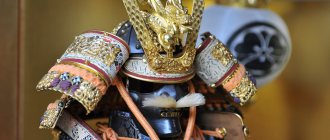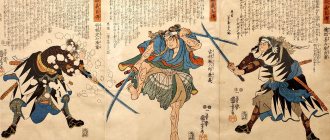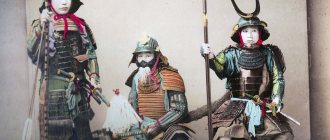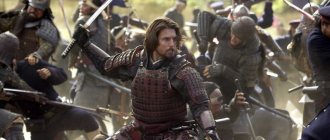The origin of legends about tengu
The tengu came to Japanese mythology from China (like many other mythological creatures). Among the Japanese, the tengu is considered a powerful mountain spirit, the lord and guardian of forests. If we compare it with its European counterparts, then the goblin or goblin will be closest to the tengu. In the Yamalo-Nenets Okrug there is a mythological character with a sonorous name - Tungu. That's what they call a wild man here. He is most often depicted as thin, tall and shaggy. Tungu can run fast and whistle shrilly (reminiscent of the Nightingale the Robber). During the cold season, the tungu covers itself with skins to keep warm.
If we talk about the word “tengu” itself, it literally means “Heavenly Dog”. The roots of this name again relate to Chinese mythology, in which there is a creature with a similar name - Tianhou ("Heavenly Hound"). According to one legend, one day a huge meteorite fell on China, and its trail looked like a large tail. This is how Tianhou got its name, and China got its legend about a powerful mountain deity, similar to a hybrid of a man and a dog, with a raven beak.
In China, and then in Japan, tengu are creatures that live in mountains and forests. According to legends, they lived as hermits, although there were cases when tengu gathered in flocks. Tengu's favorite habitats are the tops of trees (old pines or cryptomerias) whose trunks are twisted.
The tengu's appearance is quite specific - it is a huge creature with a red face and a long nose. Most likely, the tengu adopted the birdlike features of its appearance from a Chinese or Hindu prototype, and perhaps even from a merger of these images.
Tengu, of course, also have supernatural abilities. For example, they can turn into a human, and also, at will, take on the appearance of a variety of animals. Tengu can communicate with people without opening their mouths (telepathically). Also, without the help of wings, they can move from one place to another with lightning speed. And sometimes tengu can visit a person in a dream without invitation.
Tengu are considered the patrons of martial arts, as they themselves are skilled warriors. At the same time, they are not averse to playing pranks, for example, playing a trick on some boastful or arrogant monk. Tengu are distinguished by their desire for justice, and therefore can punish those who abuse power or knowledge in order to gain an influential position in society or achieve fame. In the past, tengu loved to punish vain and self-righteous samurai. In addition, they hate people with vices and braggarts.
These creatures often fool and frighten travelers going to the mountains with their thunderous laughter. They are also not averse to egging on lumberjacks who dare to wander into the depths of the thicket.
Weakened immunity
People who know the weaknesses of their body wear masks constantly. This is how they protect themselves from bacteria and viral diseases.
There is a reason for this approach - in Tokyo, for example, there are over thirty million residents, and with such a population density, the chances of getting sick are incredibly high. Therefore, the best treatment, they believe, is prevention.
However, the Japanese usually wear the same mask all day, rather than changing it every hour or two, as experts recommend. In this case, it hardly saves you from germs.
During epidemics of colds, every second person wears medical masks. Together with vaccinations and a set of antiviral tablets, this is the best way not to get infected. In addition, the fewer people who get sick, the less the disease will spread and the faster the epidemic will end.
In Japan, a person wearing a mask is a common sight, so people are not afraid of him or avoid him; rather, on the contrary, they communicate with him without fear of getting infected.
The emergence of Japanese tengu
For the first time, tengu, as a Japanese goblin, is mentioned in the “Tale of the Hollow” (“Utsubo Monogatari”), which dates back to the end of the tenth century.
Tengu came to Japan along with Buddhism in the 6th-7th centuries AD from neighboring countries - China and Korea. A little later, namely in 720, records about these creatures appear in the book of Nihon Shoki. These records were directly related to Mount Kurama, which is located near Kibune, and is the abode of the legendary white-haired tengu king called Sojobo.
According to Japanese legends and myths, tengu are descended from Susano-o (the primordial Japanese deity). Mentions of these mythical creatures can be found not only in relation to religious parables and legends, but also in ancient myths about Japanese martial arts, in particular about ninpo and ninjutsu.
According to one legend, tengu possessed “Tengu-gaijutsu-ron” (divine fighting technique). This technique is noteworthy in that it was used by ninjas who wore black clothes and a mask, which, by the way, is called Tengu-gi. The purpose of the mask was to camouflage, as well as to intimidate the enemy (it gave the appearance of a ninja demonic features). The connection between tengu and ninja will be discussed below.
The oldest type of tengu is Karasu. The painters depicted them as crow-like creatures with a human body, as well as super-strong teeth, with which they could easily bite through an iron sword, and for a snack, a spear tip.
There were legends that it was these tengu who especially carefully protected the forests in which they lived. Without hesitation, they could tear apart people who thoughtlessly cut down trees. However, tengu could deal with such intruders in a different way - they kidnapped a person, and after a while they released him. After the shock they experienced, such people became weak-minded and were popularly called “kidnapped tengu” (tengu kakushi).
Fighting cold and bad weather
In Japan it can be quite frosty in winter. While the body can be wrapped in a sweater, jacket, scarf, hat, mittens, and warm shoes, the face remains unprotected and exposed to the cold. The masks already familiar to residents come to the rescue.
The mask can protect not only from the cold, but also from wind, rain, and sometimes snow. In addition, the islands are often subject to earthquakes and typhoons, accompanied by huge clouds of dust. The situation with an accident at a nuclear power plant in 2011 is also known - then sales of masks tripled.
Yamabushi and tengu
In the 13th century, new legends appeared about the tengu. In them, tengu turn into yamabushi (mountain monks). The word “yamabushi” itself means “to settle in the mountains,” which implies the solitary wandering of monks through the mountains and gorges. These wanderings are rooted in the unique religion of Shugendo in Japan. This religion developed from the custom of honoring and worshiping local sacred mountains, which for a long time were revered as the places from which the Kami gods came or resided.
Over time, people began to create legends about these mountains, in which there was also a place for tengu. Meditation became most widespread in mountainous areas in 794-1185 (the middle of the Heian period).
They began to identify tengu with yamabushi due to the association of tengu with mountain ranges, as well as magical activities. As mentioned above, people believed in the supernatural powers of these creatures and their ability to turn into people and animals. In turn, the Yamabushi monks hoped that by secluding themselves in the mountains and leading an ascetic lifestyle as a hermit, they would be able to acquire at least some of the magical skills of the tengu. In this regard, people began to identify yamabushi with tengu and began to depict these creatures in the guise of yamabushi. Most often, tengu-yamabushi appeared in public in the guise of a barefoot wandering elderly monk, although they could easily take the form of a woman, man, or even a child.
The Yamabushi were fierce defenders of the Dharma, or otherwise the teachings of the Buddha, and therefore punished anyone who misled others using religious doctrines. In some cases, the behavior of tengu defied explanation and was mysterious to people, but such was the essence of these inhabitants of mountain forests.
Later, during the Edo period, the number of mountain monks began to grow even more, and therefore the tengu-yamabushi connection became stronger day by day. However, now the Yamabushi were no longer involved in religion, but had retrained themselves in expelling demons, curing diseases and returning stolen things. An indisputable fact is the significant influence of tengu on Japanese martial arts (ken-jutsu, ninjutsu, jujutsu, etc.), as evidenced by numerous drawings depicting tengu.
People treated tengu differently. On the one hand, these creatures were protectors and patrons of mountain sanctuaries. On the other hand, they were cruel deceivers and kidnappers of adults and children, fire starters and killers of those who encroached on trees in the tengu forests.
Tengu have a rather strange sense of humor, and their cunning is equal to their arrogance. These creatures emerge victorious from battles, thanks to their magical power, which they have more than enough. They also did not fail to use physical or mental strength.
According to popular beliefs, a proud person or a person who could not get rid of anger during life, as well as a priest who failed to know the truth or a liar who used faith for his own selfish purposes could turn into a tengu after death. Moreover, the faith in tengu was so strong that in 1860 they were even sent an official request to liberate the provinces through which the shogun was traveling.
Subculture
In Japan, there is the concept of “hikimori” - these are young people who practically do not leave home and have no contact with the outside world. They are asocial, live with their parents even at a fairly mature age (sometimes even at thirty or forty years old), and all their communication is limited to a couple of phrases with a loving mother who feeds them breakfast, lunch and dinner.
Some experts call hikimori a mental disorder. And the reason for it is considered to be overprotection on the part of parents.
Hikimori may not go outside for months, and if this happens, they cannot do without a mask. Such people have already formed a subculture, however, even within it they do not communicate. The social problem of hikimori has become increasingly widespread in Japan in recent years and is causing serious concern among psychologists.
Hikimori room
Tengu and martial arts
As noted above, tengu were unsurpassed martial artists. Despite their complex nature, sometimes tengu shared their knowledge of martial arts with ordinary people. Subsequently, various samurai, warriors, and founders of martial arts schools claimed to have received their knowledge and advice from the tengu. Sometimes this happened in a dream (as mentioned above, tengu could visit people in their dreams), and sometimes during voluntary wanderings in the mountains.
It was during just such an ascent into the Musha-shuge mountains that one of Japan's greatest warriors, Minamoto no Yoshitsune, mastered the art of using the sword. Moreover, he mastered it so well that, while still very young, he was able to defeat the warrior monk Benkei in the Kurama-dera Temple. It is quite possible that Musashi owes this knowledge to the tengu. And this is probably why the young Minamoto Musashi was called “little tengu” (the nickname was given because Musashi became the winner in more than 60 duels).
Morihei Ueshiba, the founder of the Aikido school, was very fond of one legend: the head of the Minamoto clan named Yoshitomo was defeated by the army of the Taira clan and himself died in battle. His son Ushikawa-maru's life was spared. When the boy was 7 years old, he was sent to a monastery located near Kyoto, on Mount Kurama. There he was raised by Buddhist monks and he could feel completely safe.
However, the boy was only thinking about how to avenge his father's death. So, Ushiwaka-maru began to run away from the monastery at night to train in fencing. Moreover, for this activity he chose the eerie Shojo Valley, where even during the day sunlight penetrated with great difficulty, due to the dense thickets of cedars and spruces. His enemies were thick tree trunks, in the place of which the boy represented the Taira troops. All night he stabbed them with his branch sword.
And then one evening in front of Ushiwaka-maru, a rather strange-looking yamabushi appeared from the darkness and offered the guy to learn the secrets of fencing. Ushiwaka said without hesitation for a second: “Let’s start right now!” And he immediately rushed to attack the yamabushi, but could not even touch him even once. After this, the guy more politely asked the monk to teach him.
From that day on, every night Ushiwaka-maru received the most important lessons in fencing from the master Shojo-bo and his pack of tengu. Thanks to such intensive training, by the age of 12 the guy could compete with even the strongest tengu. This meant that Ushiwaka-maru was ready to leave his teacher and the mountains.
Further, as the legend tells, Ushiwaka-maru defeats the huge monk Benkei, while proving himself to be one of the strongest Japanese warriors. And since then, all the great masters of martial arts have followed the example of Ushiwaka Maru and learned fencing from the tengu.
Japanese samurai fighting masks
What was going on in the samurai’s head always remained a mystery to his opponent, because his face was hidden by a terrible mask, one glance at which made him shiver.
Looking through pictures of battles or exhibits in a museum, at first glance the amazing combat clothing of Japanese warriors always catches the eye. Not surprising, because it differs significantly from the European armor we are used to. However, the samurai combat mask, which very often remains underestimated, looks no less mysterious.
The common name for all samurai masks is men-gu, however, over 11 centuries, about 5 varieties of combat masks have been counted.
Types of samurai masks:
- Happuri. These are the most ancient masks that were used by infantrymen until the end of the 12th century.
- Hambo. This mask could only protect the chin and lower part of the face.
- Hoate. Unlike its predecessor, it could also protect the cheeks.
- Mempo. It is believed that this is a classic Japanese war mask. She protected the entire part of her face under her eyes. Subspecies of mempo are: bizde - translated as beauty; Nara-men - a large mask with deep wrinkles; neri-ho - leather mask; Okina-bo - a mask with a very long mustache and beard; Kotakura-men - a mask imitating a crow; tengu-bo - mask with the image of the tengu demon; uba-ho - translated as “old woman”, a toothless, smooth mask with a small hole for the mouth.
- Somen. The latest type of samurai masks. It could protect the entire face of the warrior, but due to its massiveness, visibility and mobility were partially limited. This turned the somen into a ceremonial part of the uniform rather than a combat one.
Hiding feelings and withdrawing from others
Another psychological reason is the reluctance to show people your emotions. This may be a general depressed or, conversely, elated mood, or it may be an attitude of hostility towards a certain person.
Interestingly, some workers wear masks even in the office. Psychologists say that in this way they hide their true attitude towards bosses, colleagues and subordinates, accumulated emotional stress and fatigue from work.
Also, in modern cities, especially in megalopolises, many people try to isolate themselves from strangers, unnecessary questions, for example, from sales consultants, and contacts with unfamiliar people. Then they put on masks, and some also wear headphones.
One Japanese company has launched new masks that supposedly promote weight loss. They are equipped with flavors and have a matching color design. The color scheme and aroma, according to the manufacturer, stimulate metabolism and thereby put the figure in order.
External attractiveness and weight loss
As you know, Asian women consider white skin, like European women, to be one of the criteria for beauty, and they strive for it with all their might: they use whitening creams, and on the beach they wear swimsuits that cover the entire body and face. In urban environments, masks come to their aid again.
Other representatives of the fair sex say that thanks to them, others can see only a glance. And this makes a woman even more mysterious, and therefore attractive.
MASKS: A CULTURAL COMPONENT OF JAPAN
The love for anime and manga encourages fans of the genre to expand their own horizons by searching for additional information that could help understand characters or situations. The culture and mentality of the Japanese people are quite different from ours, and while some things may be intuitive, others, on the contrary, are only confusing. To learn something new about the socio-cultural component, it is enough to choose a subject of study. In our case today it will be a mask.
HISTORICAL COMPONENT
Masks as a cult object have existed among all peoples of the world since ancient times. In Japan, they were obligatory attributes of ritual games (dengaku) and performances (sarugaku, which later became the theatrical art of kyogen), from which the traditional Noh theater subsequently emerged. To some extent, sarugaku, street performances by traveling actors, can be compared with the buffoonery that is more familiar to us - the troupe’s repertoire included clowning, acrobatics, dancing, magic tricks, and the priority was entertaining people. In dengaku, entertainment took place along with a performance that depicted the struggle between the forces of good and evil for control of rice fields (or other crops). The performances were completely theatrical and, in addition to being entertaining, also had a ritual aspect.
Both dengaku and sarugaku in fact became the first public spectacles for ordinary people. It is worth noting that they not only appeared at approximately the same time (the first mentions date back to the 8th century), but also borrowed elements from each other. Masks were a mandatory prop for such games, and after the establishment of the Noh theater, they entered the history of art as a classic element of Japanese cultural heritage.
MASKS BUT
In the history of Noh theater there were different periods - both a bright heyday and a deep decline, which occurred at the end of the 19th and beginning of the 20th centuries. However, after World War II, the art of nogaku (a term that is actually synonymous with “no”) began to gain popularity again, and in 2001 it acquired the status of a “masterpiece of oral and intangible cultural heritage” by UNESCO.
Masks have always been the main means of expression in Noh theater. Their classification is quite extensive, but can be reduced to several categories: masks of elders, men and women, as well as supernatural beings (gods, demons and spirits). The variety of characters, as well as masks, subsequently influenced the depiction and perception of certain images.
MASKS IN MODERN CULTURE: ANIME AND MANGA
We rarely think about why anime and manga characters wear masks. The most obvious answer seems to be that the masks are simply part of the protagonist's character or costume. However, in fact, this is a consequence of the development of the culture of the Land of the Rising Sun, which gave the world an extensive mythology, partly reflected in the art of nogaku. The external image of many modern heroes is based (or borrowed in whole or in part) on the image and description of characters from tales, myths and legends. Spectacular performances over the centuries have shaped the collective perception of spectators, which can be observed in modern culture and its reading.
In the minds of the Japanese, a mask organically fits into the cultural component; it carries a semantic load and can have a certain meaning. Of course, the main function, identity concealment, has not changed. However, if you compare the masks of characters from Japanese culture and, for example, superheroes from American comics, you can’t help but note the diversity and style, as well as the presence of folklore motifs in the former.
Perhaps one of the most popular masks today can be considered a fox. She became famous not only thanks to Kitsune[0], a fox who can take on a human form, but also to the work of illustrators and artists from all over the world who liked this image. The fox mask can also be seen in the anime “Into the Woods Where the Fireflies Twinkle.” Gin, the main male character, received it as a gift from the spirit when he was still a baby, and in order to be more like the Others, he practically does not remove it from his face, while in his origin Gin has nothing in common with Kitsune[0].
Modernity has contributed to the cultural and historical component and today's heroes wear masks that are very similar, if not even medical or protective. What is the reason for this trend? Is this a tribute to fashion or the realities of modern Japan, reflected in popular culture?
SOCIAL INTERACTION
About a third of the residents of the Land of the Rising Sun wear masks every day, be they fabric or medical. People wear this type of mask on public transport and move around the city, attend classes and go to work - this does not surprise anyone and is considered the norm.
- caring for others and oneself
The Japanese admit that they are great workaholics, so they try not to miss a single day of work, and even when sick they will come to the office. It is worth giving them their due - first of all, they think about those around them, which is why they wear a medical mask so as not to infect any of their colleagues or simply people they meet along the way.
At the same time, those who want to protect themselves during colds and viral infections wear masks as preventive measures. Therefore, at first glance, as well as at the second, it is impossible to say for sure who is suffering from the disease on their feet and who is simply taking care of themselves.
- protection from the external environment
Polluted air and dust can cause discomfort, but there is also pollen. The spring period in Japan, when numerous plants and fruit trees bloom, is most difficult for allergy sufferers, who, in turn, try to protect themselves while moving along the street. It is worth adding that pharmaceutical companies very quickly offered reusable fabric masks with a built-in, replaceable filter as an alternative to surgical ones.
In addition, there is another option that is not entirely obvious, but really effective - a fabric mask can protect and help keep you warm during bad weather, when a cold wind is blowing and you want to wrap a warm and cozy scarf around your face.
- personal comfort
Medical masks are very popular among teenagers and young adults because they help hide skin imperfections such as pimples. In addition, if a person is embarrassed about his smile or the shape of his nose, all this can be perfectly hidden under a mask and feel more comfortable and relaxed. Again, you don’t have to wear makeup - a life hack that girls often use to reduce the time it takes to get ready for school or work in the morning; and there is also an opinion that some Japanese women, on the contrary, deliberately wear masks, in this way they strive to emphasize their expressive look. The widespread wearing of masks among young people has led to the emergence of a certain fashion - on sale you can find masks of different colors, as well as with prints, kawaii and not so much.
We should not forget that such a simple accessory helps public people to remain unnoticed in public places, that is, to remain incognito. If we talk about introverts and hikikomori (people who have deliberately chosen social isolation), shy people or those who want to hide their emotions from strangers, wearing a mask really makes it very clear to feel the boundaries of personal space and, accordingly, comfort.
METAPHOR AND CULTURAL COMPONENT
(beware, possible spoilers)
Returning to the work of Midorikawa Yuki “Into the Forest Where the Fireflies Flicker,” we should immediately clarify. The Kitsune[0] mask that Gin wears, of course, should first of all be regarded as an element of artistic device (if we talk about manga, one might say literary). A viewer who does not study Japanese culture will see in the story of Gin and Hotaru an example of a romantic story about a long-distance relationship, and in the most literal sense of these words. However, if you look a little more broadly, you can see an allusion to modern trends in the lives of young Japanese.
Gin wears a kitsune[0] mask “just because,” according to his words. When the character is revealed a little more, the viewer learns his story, sees that the mask was given to him by the spirits when they found an abandoned baby, and also notices the fact that, again, according to him, in the mask Gin looks more like the Others. That is, at first glance, this is the reason why he maintains such an appearance. However, at a certain point there is a plot twist when he gives the mask to Hotaru. What could this mean?
A beautifully veiled metaphor will be revealed if we take the features of modern social realities as a basis. Often young people want to hide their emotions from strangers, so they hide their faces under medical masks, glasses, and may even put on headphones to literally not let others into their world, which they carefully protect. According to history, Gin is one of those who prefers loneliness, is in no hurry to share his emotions and hides them in a convenient way. As both the plot and the characters develop, the young man increasingly takes off his mask, opening up and showing his eyes and smile, and eventually hands over his artifact to the girl. Based on the context, this can be interpreted as a willingness not only to accept another into your world, but also to share it.
Of course, such a meaning can be considered in a general context. However, if we take into account the trends mentioned above, a certain connection can be traced. In our culture, wearing a mask for no apparent reason raises questions; in Japan, it is a reality that is accepted with due respect.
The modern way of life dictates its own rules, so in today’s pop culture the mask has begun to acquire another associative meaning and become integrated into the cultural component. Who knows, perhaps in the future this will be perceived as a completely natural accessory for every person, although, of course, I would like the opposite. Take care of yourself.










